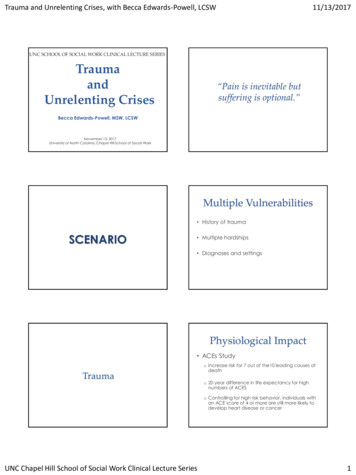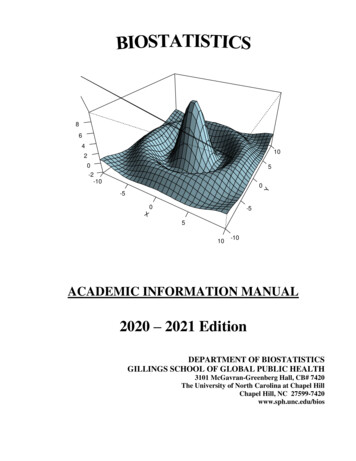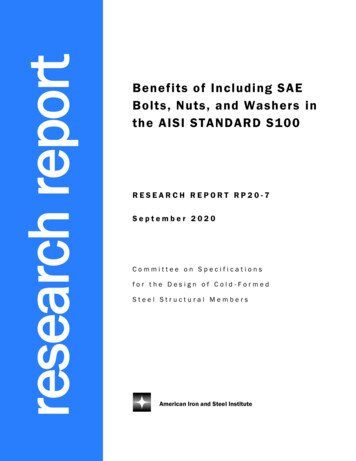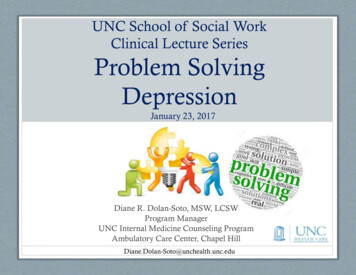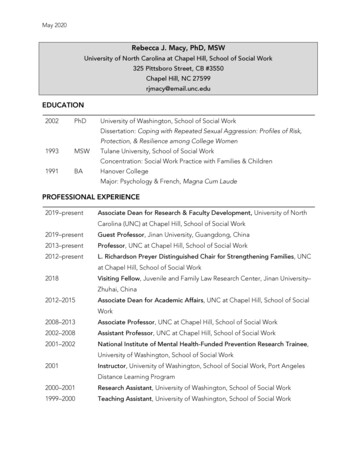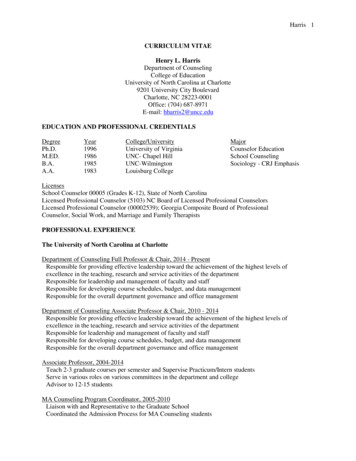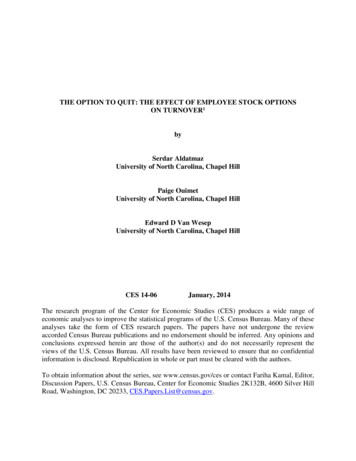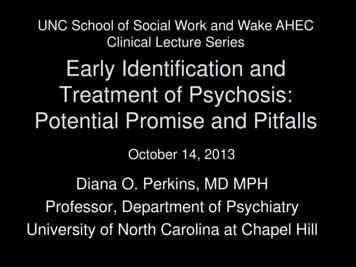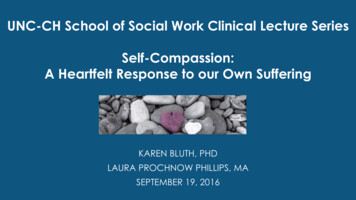
Transcription
UNC-CH School of Social Work Clinical Lecture SeriesSelf-Compassion:A Heartfelt Response to our Own SufferingKAREN BLUTH, PHDLAURA PROCHNOW PHILLIPS, MASEPTEMBER 19, 2016
Where we are going Whatis self-compassion and how does itdiffer from self-esteem? Physiology Misgivings Caringof self-compassionof self-compassionfor the caregiver Experientialexercises
Why is this relevant for socialworkers? Ownself-care Helpingclients promote own emotionalwell-being
How Would I Treat a Friend?
DefinitionsSelf-Compassion – In challenging times,treating yourself as you would treat a goodfriend (Neff, 2003).
Self-compassion Self-kindness vs. self-judgment Common humanity vs. isolation Mindfulness vs. over-identification(Neff, 2003)
Self-esteem“Global evaluation of self-worth” Pitfall#1: Comparing ourselves with others
What happens when we compareourselves with others?“Comparison is the thief of joy” - Roosevelt
Pitfall #2: Dependent on performance Whathappens when we fail?
Self-compassion Analternative way of relating to oneself Positivesof self-esteem without the pitfalls
Self-compassion vs. Self-esteem Self-compassion: Isthere when you need itmost Isnot conditional Self-esteem: Entailscomparingoneself with others Isdependent onperformance
Lovingkindness
Physiology of Self-Compassion:Threat Defense System Self-criticism stress fight/flight/freeze response
Stress is perceived in the brain
Stress is Experienced in the Body:Noticeable EffectsPupils dilateMouth drynessNeck/shouldertensionRapid heartbeatRapid, shallowbreathingSweating
Stress is Experienced in the Body:Hidden EffectsBrain gets bodyready for actionAdrenalineproducedLiver producesglucoseBlood pressure rises
Mammalian Caregiving System Productionhormonesof oxytocin and opiates – “feel good”
Soothing Touch &Self-CompassionBreak
Journal articles, chapters and dissertationsexamining self-compassion (N 1213141516
Misgivings of Self-CompassionWon’t I lose my motivation? Thosewith greater self-compassion: Moremotivated to improve personalweaknesses, moral transgressions, andtest performance (Breines & Chen, 2012) Aremore proactive (Akin, 2014) Procrastinateless (Sirois, 2013)
Isn’t this like self-pity? Or being selfish? Thosehigh in self-compassion are more likelyto: Have greater perspective, empathicconcern, altruism, compassion for humanity,readiness to forgive (Neff & Pommier, 2012) Be more caring and supportive in romanticrelationships (Neff & Beretvas, 2013) Be more compassionate to others (Gustin &Wagner, 2012; Neff & Pommier, 2012)
Sounds like self-indulgenceto me Those high in self-compassion are more likely to: Stick to one’s diet (Adams & Leary, 2007) Reduce smoking (Kelly, Zuroff, Foa, & Gilbert, 2009) Seek medical health when needed (Terry & Leary, 2011) Exercise (Magnus, Kowalski, & McHugh, 2010)
Self-compassion is weak. Thosehigher in self-compassion are betterable to cope with: trauma (Hiraoka et al., 2015; Zeller et al., 2014) divorce (Sbarra, Smith, & Mehl, 2012) chronic pain (Costa & Pinto-Gouveia, 2010) academic failure (Neff, Hseih, & Dejitthirat, 2005) child maltreatment (Játiva & Cerezo, 2014; Vettese et al., 2011)
Self-compassion & psychopathology Depression Anxiety Stress(Macbeth & Gumley, 2012)
Self-compassion and wellbeing Cognitive wellbeing Positive affect Negative affect Psychological wellbeing(Zessin, Dickhauser, & Garbade, 2015)
Self-compassion predicts wellbeing State Traitself-compassionself-compassionwellbeingless negative affectbetter overall(Zessin, Dickhauser, & Garbade,2015)
Can self-compassion be cultivated?
Mindful Self-Compassion 8 week course Meets 1x/ week for 2.5 hours One 4 hour retreat Contains mindfulness, but focus is on self-compassion Guided meditations, experiential exercises(Neff & Germer, 2013)
Hypotheses1.Increases in: Mindfulness Self-compassion Compassion forothers Socialconnectedness Happiness Life satisfactionDecreases in: Depression Anxiety Stress Avoidance2. Increases in self-compassion would predict changes3. Amount of practice is associated with amount of change
Research Design WaitlistControl InterventionINTERVENTIONTreatmentWaitlistWAITLIST CONTROLT1INTERVENTIONT2T3
Results: Differences between MSC & Control1.81.6Effect Size1.41.210.80.60.40.20(Neff & Germer, 2013)
Conclusion:Self-compassion can be taught!Course is now taught internationally & has been translatedinto 7 languages
Making Friends with Yourself: A MindfulSelf-Compassion Program forAdolescents(Bluth et al., 2016) Adapted from Neff & Germeradult Mindful Self-Compassionprogram Classes met weekly for 6weeks, 1.5 hours per week Each week included thematicdiscussion, mindful and selfcompassion activities andpractices
Percent Change from Pre- to Post-Intervention(Cohort 1 n 16, Waitlist control n 18)20100-10-20Cohort 1-30Waitlist Control
Qualitative Findings I always feel that I have to have someone else to provethat I can do things. But I have myself, and that issomeone! What I got most out of this class was reinstating thecommon humanity. Like whatever you’re feeling,you’re not alone in it. Somebody else will feel the sameway, will know where you’re coming from, even if youthink that no one understands, there will be somebodywho does.
Soothing touch:I felt like having my hands across my chest was veryanchoring. I really liked it; it was something different for me.It was nice. Very relaxing and comforting.Self-compassion break:I’ve tried the self-compassion break a few times like whenI’m really stressed out about something. I just take a breakand put it into perspective and say it’s not really that big adeal.
Main Findings MFY is feasible and acceptable MFY may be effective for promoting emotionalwell-being Changes in mindfulness and self-compassionpredicted changes in well-beingMFY is endorsed by Kristin Neff and Chris Germer as the adolescentadaptation of their Mindful Self-Compassion program.We just received an NIH grant to study MFY with teens withdepressive symptoms.
Compassionate Friend
Caring for the Caregiver
Mirror Neurons Empathic resonance
Empathic resonance Feeling Canwhat others feel, including their painlead to vicarious traumatization andburnout
Empathy Fatiguehttps://www.youtube.com/watch?v khjPsVG-6QA
Through our own selfcare we can be morepresent for others.
Self-compassion provides: Lessburnout and compassion fatigue More satisfaction with caregiving role
Compassion for Self and Others
For someone to develop genuine compassion towardsothers, first he or she must have a basis upon which tocultivate compassion,and that basis is the ability to connect to one’s ownfeelings and to care for one’s own welfare Caring for others requires caring for oneself. DalaiLama (2000)
The intimacy that arises in listening and speakingtruth is only possible if we can open to thevulnerability of our own hearts. Breathing in,contacting the life that is right here, is our first step.Once we have held ourselves with kindness, we cantouch others in a vital and healing way. Tara Brach, psychologist and meditationteacher
The curious paradoxis that only when Iaccept myself justas I am, then I canchange. Carl Rogers
We do not have to improve ourselves; wejust have to let go of what blocks ourheart. Jack Kornfield
Wild Geeseby Mary Oliver
Learn more about self-compassion: Coursesat s-program/msc Self-compassion in general:www.selfcompassion.org Self-compassion for teens:www.mindfulselfcompassionforteens.com
Tara Brach, psychologist and meditation teacher. The curious paradox is that only when I accept myself just as I am, then I can change. Carl Rogers. We do not have to improve ourselves; we just have to let go of what blocks our heart. Jack Kornfield. Wild Geese by Mary Oliver.


